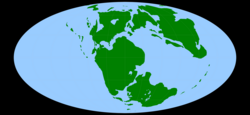
Back Jura AF Jura (Geologie) ALS Churasico AN العصر الجوراسي Arabic Xurásicu AST Yura dövrü AZ Юрскі перыяд BE Юра BE-X-OLD Юра Bulgarian Jura (pariuda) BJN
| Jurassic | |||||||||
|---|---|---|---|---|---|---|---|---|---|
 A map of the world as it appeared during the Middle Jurassic, c. 170 Ma. | |||||||||
| Chronology | |||||||||
| |||||||||
| Etymology | |||||||||
| Name formality | Formal | ||||||||
| Usage information | |||||||||
| Regional usage | Global (ICS) | ||||||||
| Time scale(s) used | ICS Time Scale | ||||||||
| Definition | |||||||||
| Chronological unit | Period | ||||||||
| Stratigraphic unit | System | ||||||||
| Time span formality | Formal | ||||||||
| Lower boundary definition | First appearance of the ammonite Psiloceras spelae tirolicum. | ||||||||
| Lower boundary GSSP | Kuhjoch section, Karwendel mountains, Northern Calcareous Alps, Austria 47°29′02″N 11°31′50″E / 47.4839°N 11.5306°E | ||||||||
| Lower GSSP ratified | 2010 | ||||||||
| Upper boundary definition | Not formally defined | ||||||||
| Upper boundary definition candidates |
| ||||||||
| Upper boundary GSSP candidate section(s) | None | ||||||||
The Jurassic (/dʒʊˈræsɪk/ juu-RASS-ik[2]) is a geologic period and stratigraphic system that spanned from the end of the Triassic Period 201.4 million years ago (Mya) to the beginning of the Cretaceous Period, approximately 145 Mya. The Jurassic constitutes the middle period of the Mesozoic Era and is named after the Jura Mountains, where limestone strata from the period were first identified.
The start of the Jurassic was marked by the major Triassic–Jurassic extinction event, associated with the eruption of the Central Atlantic Magmatic Province (CAMP). The beginning of the Toarcian Stage started around 183 million years ago and is marked by the Toarcian Oceanic Anoxic Event, a global episode of oceanic anoxia, ocean acidification, and elevated global temperatures associated with extinctions, likely caused by the eruption of the Karoo-Ferrar large igneous provinces. The end of the Jurassic, however, has no clear, definitive boundary with the Cretaceous and is the only boundary between geological periods to remain formally undefined.
By the beginning of the Jurassic, the supercontinent Pangaea had begun rifting into two landmasses: Laurasia to the north and Gondwana to the south. The climate of the Jurassic was warmer than the present, and there were no ice caps. Forests grew close to the poles, with large arid expanses in the lower latitudes.
On land, the fauna transitioned from the Triassic fauna, dominated jointly by dinosauromorph and pseudosuchian archosaurs, to one dominated by dinosaurs alone. The first birds appeared during the Jurassic, evolving from a branch of theropod dinosaurs. Other major events include the appearance of the earliest crabs and modern lizards, and the diversification of early mammals. Crocodylomorphs made the transition from a terrestrial to an aquatic life. The oceans were inhabited by marine reptiles such as ichthyosaurs and plesiosaurs, while pterosaurs were the dominant flying vertebrates. Modern sharks and rays first appeared and diversified during the period. The flora was dominated by ferns and gymnosperms, including conifers, of which many modern groups made their first appearance during the period, as well as other groups the extinct Bennettitales.
- ^ "International Chronostratigraphic Chart" (PDF). International Commission on Stratigraphy.
- ^ "Dictionary.com | Meanings & Definitions of English Words". Dictionary.com. 2024-04-17. Retrieved 2024-04-18.